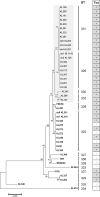Multilocus sequence typing of Corynebacterium ulcerans provides evidence for zoonotic transmission and for increased prevalence of certain sequence types among toxigenic strains
- PMID: 25320226
- PMCID: PMC4313305
- DOI: 10.1128/JCM.02291-14
Multilocus sequence typing of Corynebacterium ulcerans provides evidence for zoonotic transmission and for increased prevalence of certain sequence types among toxigenic strains
Abstract
Human-to-human-transmitted Corynebacterium diphtheriae was historically the main pathogen causing diphtheria and has therefore been studied extensively in the past. More recently, diphtheria caused by toxigenic Corynebacterium ulcerans is an emerging disease in several industrial countries, including the United Kingdom, the United States, France, and Germany. However, toxigenic C. ulcerans has so far been almost neglected in the development of epidemiologic tools. One of the most important tools in modern epidemiology to understand transmission pathways is sequence typing of pathogens. Here, we provide a protocol for multilocus sequence typing (MLST) to type C. ulcerans strains rapidly and relatively cost-effectively. Applying MLST to C. ulcerans for the first time, we show that related sequence types (STs) might be associated with the presence of the diphtheria toxin gene, which encodes diphtheria toxin (DT), the most important diphtheria-causing virulence factor. Interestingly, we found only two very closely related STs in the isolates derived from six dogs. Additionally, our data show that all STs derived from animals which were at least twice present in our analysis were found in humans as well. This finding is congruent with zoonotic transmission of C. ulcerans.
Copyright © 2014, American Society for Microbiology. All Rights Reserved.
Figures


References
-
- Bolt F, Cassiday P, Tondella ML, Dezoysa A, Efstratiou A, Sing A, Zasada A, Bernard K, Guiso N, Badell E, Rosso ML, Baldwin A, Dowson C. 2010. Multilocus sequence typing identifies evidence for recombination and two distinct lineages of Corynebacterium diphtheriae. J. Clin. Microbiol. 48:4177–4185. 10.1128/JCM.00274-10. - DOI - PMC - PubMed
Publication types
MeSH terms
Substances
LinkOut - more resources
Full Text Sources
Other Literature Sources
Medical
Miscellaneous

